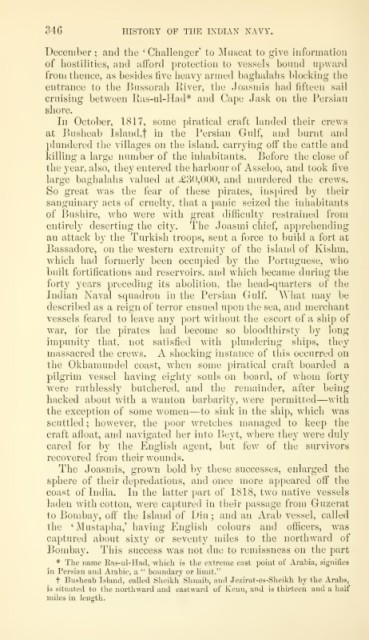Page 378 - INDIANNAVYV1
P. 378
346 HISTORY OF THE INDIAN NAVY.
December; and the 'Challenger' to j\Iuscat to give information
of hostilities, and afford protection to vessels bound upward
from thence, as besides live heavy armed baghalahs blocking the
entrance to the Bussorah River, the Joasmis had fifteen sail
cruising between Ras-ul-Had* and Cape Jask on the Persian
shore.
In October, 1817, some piratical craft landed their crews
at Busheab Island,t in the Persian Gulf, and burnt and
plundered the villages on the island, carr3'ing off the cattle and
killing a large number of the inhabitants. Before the close of
the year, also, they entered the harbour of Asseloo, and took five
large baghalahs valued at de3(),000, and murdered the crews.
So great was the fear of these pirates, inspired by their
sanguinary acts of crueltj^ that a panic seized the inhabitants
of Bushire, who were with great difficulty restrained from
entirely deserting the city. The Joasmi chief, apprehending
an attack by the Turkish troops, sent a force to build a fort at
Bassadore, on the western extremity of the island of Kishm,
which had formerly been occupied by the Portuguese, who
built fortifications and reservoirs, and which became during the
forty years preceding its abolition, the head-quarters of the
Indian Naval squadron in the Persian Gulf. What may be
described as a reign of terror ensued upon the sea, and merchant
vessels feared to leave any port without the escort of a ship of
war, for the pirates had become so bloodthirsty by long
impunity that, not satisfied with plundering ships, they
massacred the crews. A shocking instance of this occurred on
the Okhamundel coast, when some piratical craft boarded a
pilgrim vessel having eighty souls on board, of whom forty
were ruthlessly butchered, and the remainder, after being
backed about with a wanton barbarity, were permitted—with
the exception of some women—to sink in the ship, which was
scuttled ; however, the poor wretches managed to keep the
craft afloat, and navigated her into Beyt, where they were duly
cared for by the English agent, but few of the survivors
recovered from their wounds.
The Joasmis, grown bold by thes« successes, enlarged the
sphere of their depredations, and once more appeared off the
coast of India. In the latter part of 1818, two native vessels
laden with cotton, were captured in their passage from Guzerat
to Bombay, off the Island of Diu ; and an Arab vessel, called
the ' MuRtapha,' having English colours and officers, was
captured about sixty or seventy miles to the northward of
Bombay. This success was not due to remissness on the part
* The name Ras-ul-Had, which is the extreme east point of Arabia, signiiies
in Persian and Arabic, a " boundary or limit."
t Busheab Island, called Sheikh Shuaib, and Jezii-at-es-Sheikli by the Arabs,
is situated to the northward and eastward of Kenn, and is tliii'teen and a half
miles in length.

